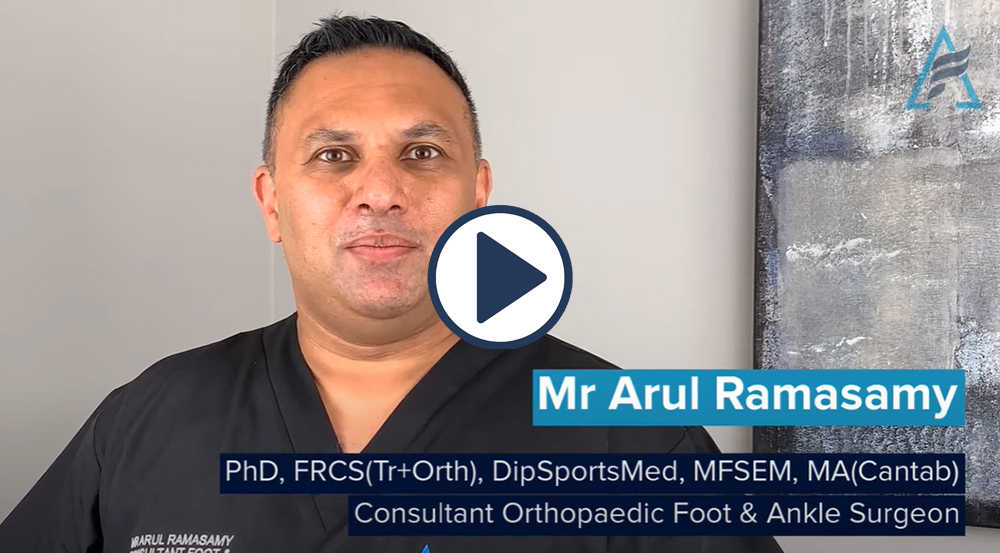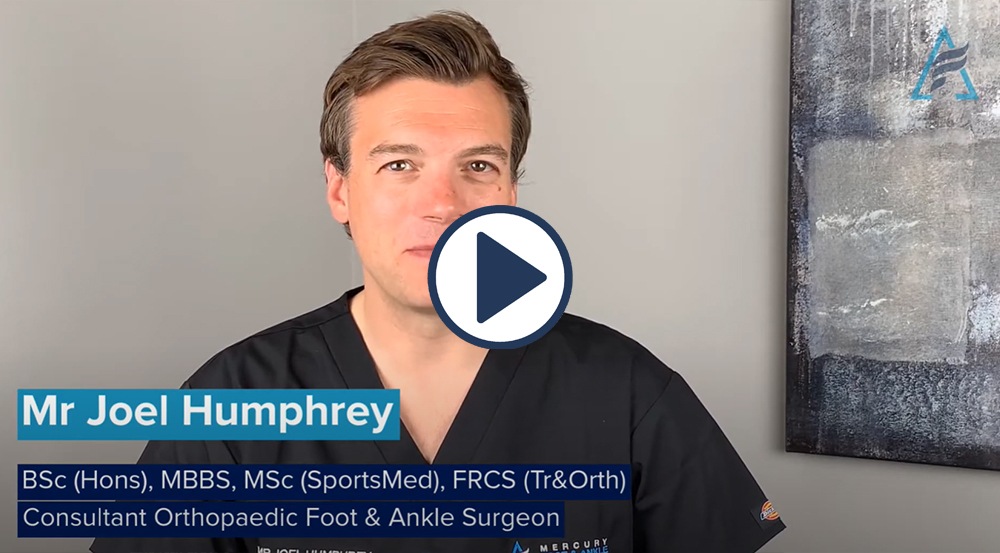Adult Acquired Flatfoot

What is the medial arch of the foot?
The medial arch of the foot is the most prominent foot arch. It runs along the inside of the foot. The arch is formed by the tarsal and metatarsal bones, and is supported by ligaments and tendons in the foot. It acts a shock absorber, whilst walking and running.
What is adult acquired flatfoot?
Adult acquired flatfoot is a progressive flattening or collapse of the medial arch of the foot. The condition develops in those over the age of 40 and is more frequent in women than men. It can also be known as “fallen arches”. Adult acquired flatfoot can progress from early stages with pain along the inside of the foot and ankle to advanced deformity and arthritis.
How is adult acquired flatfoot different form flexible flatfeet? Flexible flatfeet are the commonest cause of a flatfoot. The medial arch of the foot is flattened but appears when standing on tiptoes. It is normal for children up to five years of age to have flexible flatfeet. The majority grow out of their flatfeet when the medial arch of the foot develops in early childhood. In some cases though it can last through adulthood. With flexible flatfeet there is no structural abnormality and only a small number will ever have a problem.
What causes adult acquired flatfoot?
The most common causes of an adult acquired flatfoot is posterior tibial tendon dysfunction (PTTD). The posterior tibial tendon is one of the major supporting structures of the medial arch of the foot. If the posterior tibial tendon becomes inflamed, overused or torn it can stretch, causing the medial arch of the foot to collapse. It commonly occurs from cumulative wear and tear of the posterior tibial tendon, rather than a specific event. People with pre-existing flexible flatfeet, diabetes, hypertension, obesity and rheumatoid arthritis are more prone to the condition. High impact sports are also a contributory factor.
What are the symptoms of adult acquired flatfoot?
The symptoms of adult acquired flatfoot are varied and depend on the cause of the condition. If it is caused by PTTD, there may initially be pain and swelling along the inside of the ankle where the tendon runs. This then leads to increased flattening of the medial arch of the foot and inability to raise up onto tip toes. Over time the pain moves to the outside of the ankle as the heel tilts outwards. If arthritis develops the foot can become stiff with difficulty walking on uneven surfaces.
How is adult acquired flatfoot treated?
Because of the progressive nature of adult acquired flatfoot secondary to PTTD early treatment is advised. If treated early enough symptoms may resolve with non-surgical treatment and progression of the condition may be prevented. Some of the treatments for PTTD are discussed below, but it is not exhaustive.
With early-stage disease that involves pain along the posterior tibial tendon and without flattening of the medial arch of the foot, immobilisation with a boot for a period of time in-conjunction with rest, elevation, ice and anti-inflammatory medications can reduce the stress and inflammation on the tendon.
Ask advice from your doctor or pharmacist before taking anti-inflammatory medicines as they can have side-effects in some people.
Once these acute symptoms have settled an orthosis (medical insole) or bracing can further rest the tendon and improve it’s mechanical function. Specific physiotherapy exercises to strengthen the tendon are important and weight loss also helps reduce the symptoms.
If the medial arch of the foot has already collapsed it can still be managed with non-surgically with long term a custom-made orthosis and appropriate footwear. With a mobile deformity medial arch orthotics can correct the foot position. It can take several months to find out if they are beneficial. If these measures are not successful in controlling the symptoms then surgery can be considered.
The specifics of surgery depend on the stage of the condition. In general, an adult acquired flatfoot that is mobile and without arthritis can be treated with flatfoot reconstruction surgery to restore the shape of the foot. An adult acquired flatfoot with a fixed deformity or with associated arthritis can be treated with a hindfoot (triple) fusion to stiffen the three joints in the back of the foot.
Wellbeing Advice
Patients that have a healthy diet, take regular exercise and refrain from smoking are more likely to experience a quicker recovery with a more successful outcome from their surgery.
If you have any concerns about your general health and well-being (diet, exercise, smoking cessation) you are encouraged to discuss this with your GP, who will be able to provide advice on the options available to you.
We hope this leaflet has answered any questions you might have. If you have any further queries, please feel free to discuss them with any of the medical or nursing staff.
Testimonials

My condition had deteriorated to the point that I was unable to walk for extended periods of time without pain and swelling of the ankle, and I would rarely be able to join in most family activities. The support and guidance provided by Mr Ramasamy were exemplary and enabled me to make a fully informed decision regarding the options available to me. Now, the pain is much more manageable and the stability that the treatment has provided is such that I feel that I regained a significant part of my life and as such my confidence.
I found Mr Ramasamy extremely professional and reassuring. On the day of my procedure I received the most efficient, organised and professional care in my life. Your nurses were the best I have ever experienced. Mr Ramasamy’s team, in theatre made me feel at ease and made the whole procedure more bearable. They go way beyond the extra mile for their patients.
I wanted to share my excellent experiences and compliment Mr Ramasamy and his team. I found him extremely professional and reassured that he understood how much pain I was in. On the day of my procedure, it was the most efficient, organized and professional care I have ever received – from checking into reception to being allocated a bay and taken into theatre – your nurses in the recovery area were the best I have ever received. Mr Ramasay’s team, especially in theatre, made me feel at ease, kept me informed throughout the whole procedure and made the whole procedure more bearable.
Send Us A Message

If you have a question or want to reach out to us directly, use the contact form below and send us a message.








